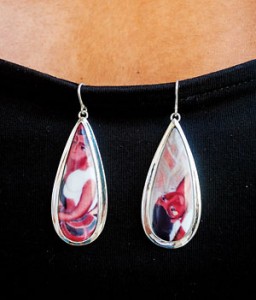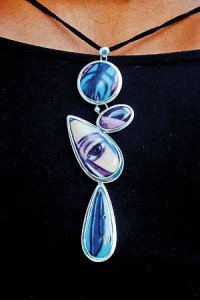Decked in ‘43 group
 Imagine wearing the very distinct lines of George Keyt’s most famous work around your neck, on your ears and on your wrist. Sounds strange? That’s what keeps Mihiri Devendra on her toes. The designer has collaborated with the Sapumal Foundation for an exhibition of “wearable art” entitled Collection 43; jewellery that uses iconic artwork by the ‘43 Group as its starting point.
Imagine wearing the very distinct lines of George Keyt’s most famous work around your neck, on your ears and on your wrist. Sounds strange? That’s what keeps Mihiri Devendra on her toes. The designer has collaborated with the Sapumal Foundation for an exhibition of “wearable art” entitled Collection 43; jewellery that uses iconic artwork by the ‘43 Group as its starting point.
The jewellery will nestle amongst the work of some of Sri Lanka’s finest modern artists at the Sapumal Foundation on Barnes Place. Mihiri approached the foundation’s chairman Rohan de Soysa with her idea last year. Mr. de Soysa was almost immediately on board. “I thought it was very creative,” he says. “I also thought it sounded difficult to put a painting into a piece of jewellery but I had been to Mihiri’s exhibitions before and she’s very talented.”
The Sapumal Foundation houses an impressive collection of work by the ’43 Group, a collective of artists that changed the scope for art in Sri Lanka with their passion for contemporary art. Spearheaded by the photographer Lionel Wendt and artist Harry Pieris, the group included artists such as Geoffry Beling, Richard Gabriel, Ivan Peries, George Keyt, George Claessen, Aubrey Collette, Justin Daraniyagala and Ven. Manjusri Thera (LTP Manjusri).
Mihiri has chosen the work of these ten artists for her collection. The concept of ‘wearable art’ is behind her brand LEAP by Mihiri; “For me, what’s interesting is how far I can push the materials I’m working with,” she says. “I’ve never been able to work within lines anyway!”
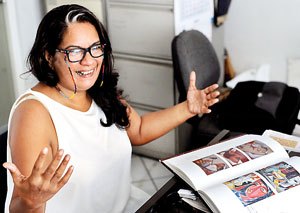
Mihiri Devendra explains her work. Pic by Amila Gamage
The artist cum designer first discovered her knack for jewellery design at the Cora Abraham Art Classes, where she was taught by Nalini Weerasinghe. The instructor realised that her student had an eye for detail and encouraged her to pursue jewellery design. Although the trade runs in her family Mihiri had never considered it an option before. But at her teacher’s behest and with encouragement from Mallika Hemachandra, a family friend, she pursued a diploma programme where her creative impetus was tempered with technical knowledge. She worked with several jewellers for years before striking out on her own, and now works on a much more exclusive scale-doing pieces that she says speak to her.
Collection 43 is driven by an appreciation for the talent of the artists that it features as much as a desire to share their work with a generation that has already forgotten or simply not known, says Mihiri. “This seemed like a wonderful way to bring knowledge and exposure to a larger audience,” she smiles. “The foundation has been generous in allowing me to go ahead with the idea.”
Using porcelain as her base, the designer uses screen printing and laser printing techniques to transfer selected sections of the artwork from each painting on to the jewellery. She prefers screen printing for its authenticity but says laser printing has been more effective in maintaining the vibrancy of the colour palettes. Using photographs of the artwork provided by Mr. de Soysa, she used stencils to isolate sections from each piece, realigning them to suit the shape of the tiles. 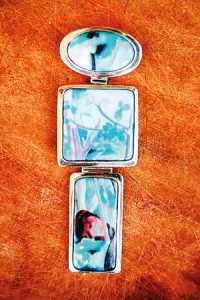
Mihiri has included at least one work by the ten artists she chose; although she has a special place in her heart for Keyt’s work-simply because his style was versatile spanning a number of years. Keyt’s early work is softer, more classical. He almost became a monk, notes Mr. de Soysa, as he shows me a photograph of the original “Buddhist Monks”, an oil on canvas. The cubic style of Keyt’s later work hasn’t necessarily made translating his work onto jewellery easier, Mihiri says, but it has allowed more room for realignment and juxtaposition.
Mihiri also uses a few photographs by Lionel Wendt and her aunt Chithra Premaratne Stuiver. These mixed mediums are indication of the direction she hopes to take with her work -plans are already underway in the form of partnerships to use the same idea to design jewellery as souvenirs.
“Collection 43” is an open exhibition at the Sapumal Foundation on June 10, 11 and 12 from 10 am to 6 p.m. Buyers of the jewellery will receive a certificate of origin and a brief on the artist featured and the item purchased.
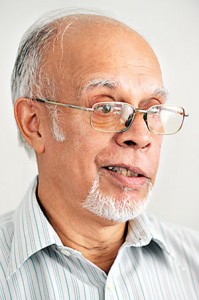
Rohan de Soysa
